Rockaway, Queens
Rockaway | |
|---|---|
Cluster of neighborhoods in Queens | |
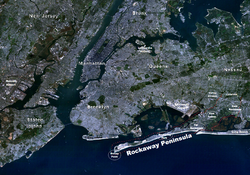 Rockaway Peninsula along the coast of Queens | |
 | |
| Country | United States |
| State | New York |
| City | New York City |
| Borough/County | Queens |
| Named for | Corruption of original Lenape language name |
| Population | |
• Estimate (2007) | 130,000 |
| ZIP code | |
| Area code(s) | 718, 347, and 917 |
The Rockaway Peninsula, commonly referred to as The Rockaways or Rockaway, is the name of a peninsula on Long Island, New York, all of which is located within the New York City borough of Queens. A popular summer resort area since the 1830s, Rockaway has become a mixture of lower, middle, and upper-class neighborhoods. Its relative isolation from the urban areas of the city, especially Manhattan, has traditionally made it a popular summer retreat. In the 2010s, it became one of the city's most quickly gentrifying neighborhoods.
The neighborhood is part of Queens Community Board 14.[1] As of January 1, 2007, the peninsula's total population is estimated to be just below 130,000.[2] Rockaway is entirely in New York's 5th congressional district represented by Congressman Gregory Meeks. All ZIP codes in Rockaway begin with 116- and the central post office is in Far Rockaway.
History
Early history


What is now known as Rockaway was inhabited by the Lenape Native Americans, but sold to the Dutch by the Mohegan tribe along with most of Long Island in 1639,[3] and to the British in 1685.[4] Finally the land was sold to Richard Cornell, who settled there.[5] The name "rockaway" is the later corruption of a Lenape language word that sounded phonetically something like "rack-a-wak-e", and referred to the area. It may have meant "place of sands" (see: Toponymy of New Netherland and Metoac#Exonyms).
Rockaway became a popular area for seaside hotels starting in the 1830s, and its popularity grew with the coming of the Long Island Rail Road's Rockaway Beach Branch to Long Island City and Flatbush Terminal (now Atlantic Terminal), which facilitated population growth on the Rockaway Peninsula when it opened in the 1880s.[6]
In 1878, the eastern community of Bayswater was laid out. One of Bayswater's early developers was William Trist Bailey, who had purchased the property.[7]
In 1893, much of Hog Island, a small sandbar island off the coast of Far Rockaway washed away in a hurricane.[8] The remainder of the island eroded away by 1902. Plates, along with older artifacts, still wash up along the shore of Rockaway Beach.[9][10]
The Rockaway Peninsula was originally part of the Town of Hempstead, then a part of Queens County. In 1897, the central peninsular towns of Hammels (named after a local landowner, Louis Hammels[6]) and Hollands merged, and were incorporated as the Village of Rockaway Beach. The entire borough of Queens was consolidated of Greater New York City in 1898.[11] The village of Rockaway Park became incorporated into the City of Greater New York on January 1, 1898.
Early 20th century
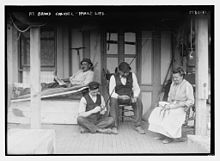
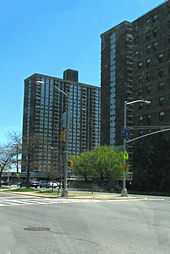
In the early 1900s, the newly built railroad station opened up the community and the rest of the peninsula to a broad range of the population. The wealthy no longer had a monopoly on the peninsula, as various amusement parks, stores, and resort hotels attracted people from all over the city to spend a day or a whole summer there. Much of the area was developed by James S. Remsen and William Wainwright. In this era, it became known as "New York's Playground". Around this time, Breezy Point in the Rockaways began as summer beach bungalow; the bungalow became the most popular type of housing during the summer months. Even today, some of these remain, converted to provide modern amenities, although the vast majority were razed in urban renewal during the 1960s.[12]
In 1900, a New York State judge ordered that the land west of Rockaway Park be put up for auction. Belle Harbor and adjacent Neponsit was bought by Edward P. Hatch, who sold it to the West Rockaway Land Company in 1907.[13] The president of the company, Frederick J. Lancaster, who had earlier developed the Edgemere neighborhood, officially gave the community its name.[14] Prior to Lancaster's acquisition of the land, however, a group of men wishing to form a yacht club entered into an grant agreement with the West Rockaway Land Company in 1905. The group, which had named itself the Belle Harbor Yacht Club, bought property from the company for four-thousand dollars. The agreement included two-hundred square feet of land and thirty plots of upland. That same year the group received corporation status by the State of New York and by 1908 began participating in its first inter-club ocean races with some of the city's other yacht clubs.[15]
The central-peninsula neighborhood of Hammels, along with the eastern communities of Arverne and Far Rockaway, tried to secede from the city several times. In 1915 and 1917, a bill approving the secession passed in the legislature but was vetoed by the mayor at the time, John Purroy Mitchel.[16]
Rockaway's famous amusement park, Rockaways' Playland, was built in 1901 and quickly became a major attraction for people around the region. With its growing popularity, concern over swimming etiquette became a problem and early in 1904, the Captain of the NYPD, Louis Kreuscher, issued rules for those using the beach, censoring the bathing suits to be worn, where photographs could be taken, and specifying that women in bathing suits were not allowed to leave the beachfront.[17] The park was grand for its time. One of its most popular attractions, the Atom Smasher roller coaster, would be featured in the beginning of This is Cinerama, a pre-IMAX type movie, in 1952.[18] An Olympic-size swimming pool and a million-dollar midway also were built within the amusement park; they would serve the community for over eighty years.[19] It was a popular place for New York families until 1985 when insurance costs and competition from major regional parks made it impossible to continue operations.[5]
Arverne became well known as a beachfront community with inexpensive summer bungalows, and hotels of varying levels of expense and luxury as well as amusements and boardwalk concessions, and it also attracted a year-round residential community. One grandiose plan for the community included a canal running through the neighborhood, reminiscent of the Amstel canal in Amsterdam, the Netherlands; however, the canal was not constructed and the canal right-of-way was converted into a thoroughfare, Amstel Boulevard, which, except for a stub west of Beach 71st Street, was later incorporated into Beach Channel Drive.
The first transatlantic flight departed from Neponsit on the Rockaway Peninsula. On May 8, 1919, four United States Navy-Curtis model seaplanes took off from what is now Beach Channel Drive in Neponsit to Newfoundland, Canada, the Azores Islands, and Lisbon, Portugal. Finally on May 31, 1919, only one plane, piloted by Lt. Commander Albert C. Read, arrived in Plymouth, England.[20]
Robert Moses era

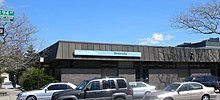
In the 1930s, Robert Moses came to power as New York City's Parks Commissioner and his extensive road and transportation projects were both a benefit and disaster for the neighborhood. As commissioner, Moses ordered the construction of the Marine Parkway Bridge and the Cross Bay Veterans Memorial Bridge. The bridges were completed in 1937 and 1939 respectively. The Marine Parkway Bridge was built further west on the peninsula between Jacob Riis Park and Breezy Point linking the isolated communities to Brooklyn. The Cross Bay Bridge landed in the middle of the neighborhood of Rockaway Beach.[21][22] The construction of the two bridges started to transform the neighborhood and the rest of the peninsula into a more year-round residential area or commuter town, as people had a more convenient way to travel to and from work. The conversion of the Rockaway Beach LIRR branch to the Rockaway subway line also brought an increase to Rockaway's permanent residents.
Although the bridges were intended to improve the Rockaways, Moses' other projects both directly and indirectly hurt the community. One such failed project was the planned construction of the Shore Front Parkway in the 1950s and 1960s. Wanting to connect Staten Island to the Hamptons, Moses focused on making a highway through the Rockaway Peninsula. His idea was to connect the Marine Parkway Bridge with the Atlantic Beach Bridge, which connected the Rockaway Peninsula to Nassau County. The plan would also provide an extension midway through to include the Cross Bay Bridge. Many feared that such an extensive project would do more harm to the peninsula than good and pointed to the community displacement that had happened in the South Bronx because of Moses' roadway construction[23] Even though Moses never got to make his highway, he did leave his mark. A piece of the planned parkway that ran west to east in the Rockaway Park and Rockaway Beach neighborhoods was constructed and opened in 1939. Houses were literally cut in half in order to build the four-lane street. Some of these houses are still standing today. The existing, still unfinished street is locally known as the "road from nowhere to nowhere" because it does not have any relevant connections to any other area or highway.[24]
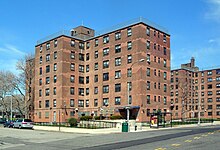
Robert Moses' construction of other recreational areas and facilities, such as the New York Aquarium and Jones Beach State Park, indirectly impacted the neighborhood as well. These more modern recreational facilities lured tourists and beachgoers away from the peninsula. With fewer customers, businesses and hotels closed, and by the 1950s, the area had fallen into economic decline. The transition from a summer vacationing area to a full-time residential neighborhood had taken its toll.[25]
Late 20th century
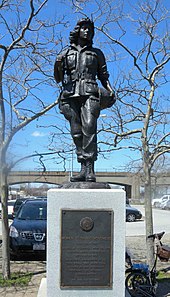
In the years immediately following World War II, several public housing projects were built in the region, and these eventually became hotbeds of crime and related social pathologies. This provoked a backlash from some of the peninsula's more established residents (many of whom are of Irish Catholic heritage). A strong Jewish community (most of whose members are Ashkenazi Jews) also exists in the area around Far Rockaway. For example, the city constructed the Hammel Houses in Rockaway Beach. This project would be one of the many so-called urban renewal efforts that dominated the community and much of its eastern neighbors in the last half of the 20th century. The New York City Housing Authority purchased the land in 1952 on the north side of the elevated track. In 1964, the Authority decided to demolish and rebuild the entire area and turn it into a park.[25]
With the advent of inexpensive travel, air-conditioning, John F. Kennedy International Airport, and the Interstate Highway system, Rockaway lost its luster as a recreation area, and development transformed much of it into residential communities
In 1960, Breezy Point was sold to the Atlantic Improvement State Corporation for $17 million in 1960; the residents of the 3,500-home community purchased half of the land for approximately $11 million and formed the Breezy Point Cooperative.[26] The construction of apartment buildings commenced in the late 1960s and was halted by City ordinance.[27] At the same time, much of the housing in the area was converted into year-round housing for low-income residents, and some of the bungalows were used as public housing.[28][29]
Around the same time, the Arverne area was slated for a large redevelopment that never came; the area's redevelopment was cancelled after economic downturn in the 1990s. According to a 2003 New York Times article:
For nearly four decades, grand plans were offered for the 52-block stretch from Beach 32nd to 84th Streets, between Rockaway Beach Boulevard and the boardwalk. [There was to be] a phalanx of mid- and high-rise condominium and rental apartment buildings, [as well as] more than $1 billion... enclosed amusement area on the Arverne site, to be called Destination Technodome, with rides, movie theaters, an indoor ski slope and a hotel.[30]
Until 1975, an additional fare was charged to passengers departing the IND Rockaway Line (A and S trains of the New York City Subway) in any of the Rockaway-area stations, including Broad Channel, if the trip originated or terminated outside the area (in addition to the standard entry fare).
In 1982, New York City granted Broad Channel residents the right to purchase their property.
In 1998, Broad Channel's Labor Day parade received negative media attention after video of a float that parodied the racially motivated dragging death of an African American man, James Byrd, Jr., was made public. The float carried white men wearing blackface and Afro wigs, and was entitled "Black to the Future - Broad Channel in 2098". Three white participants on the float, two city firefighters and a city police officer, were later fired from their jobs as a result of the parade incident.[31] They sued the city for wrongful termination, and had their claims upheld in federal district court in 2003. Local residents expressed support for and relief at the ruling, hoping that an end to the court battle would help to rehabilitate the image of the town.[32] The United States Court of Appeals for the Second Circuit reversed the ruling in 2006, holding that the firings could stand.[33]
Redevelopment
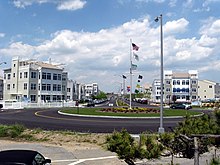
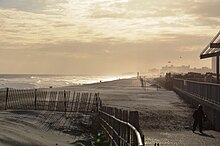
Redevelopment has started in some areas of the peninsula. Although various plans, including casinos, sports arenas, and other real-estate projects had been proposed in the past, many of these did not come to fruition due to either lack of funds, development stagnation, or resident resistance. However, in 2002, a "revival" began on the peninsula, as a new residential development plan started construction in a large vacant section between Rockaway Beach and Arverne. The new areas have become known as Arverne By the Sea[34] and Arverne East.[35] Far Rockaway Shopping Center, in downtown Far Rockaway between the [[Far Rockaway – Mott Avenue (IND Rockaway Line)|Far Rockaway A train subway station]], and the Far Rockaway LIRR station, got its first new store in decades, with others soon to follow as the run-down center was renovated.[36] Then-Mayor Michael Bloomberg started to construct new housing and parks in Arverne-by-the-Sea, starting with 400 houses in Arverne.[37] The Rockaways increasingly got attention and press as the redevelopment of the beachfront continued.[38] Phase I of construction was completed in 2011; Phase II was begun in 2006.[39] By 2012, Arverne-by-the-Sea was largely developed with some parts under new construction.[40] The area now has new retail establishments, such as Stop and Shop Grocery Store, Chase bank branch, restaurants, and Subway sandwiches.
The piece of the Arverne-by-the-Sea development in Arverne is mostly complete. However, the section of the development west of Beach 59th Street, in nearby Edgemere, named "Arverne East", is still under construction. As of 2003[update], this 97 acres (39 ha) "Edgemere Urban Renewal Area" will have 400 houses built within it.[41] Of these, 47 acres (19 ha) are houses, 35 acres (14 ha) is a nature preserve, and 15 acres (6.1 ha) is a segment of preserved dunes on the beach.[39]
The new development projects, however, have sparked a new building boom in the neighboring communities. This has caused some concern and has led to various debates regarding development within those neighborhoods. The main problem has to do with Rockaway's zoning laws: those laws, decades old, cater to large multiple dwellings because of the hotels that had once existed in the area. This has led to construction of taller and wider buildings in areas that currently contain lower density housing. In response, some communities have approved rezoning plans for their neighborhoods in order to stop "out of character" development.[42]
Opponents also contend that due to the rapidly growing population,[43] the current infrastructure is inadequate and that there are environmental issues to consider. Those in favor of the development, however, contend that the development will help spur economic development and that the infrastructure cannot be upgraded until the population has reached a more noticeable level. Furthermore, some developers have questioned the legality of "down zoning".[44] On August 14, 2008, however, a rezoning plan was approved by the New York City Council for five communities on the peninsula covering 280 blocks. The communities that were included are Rockaway Park, Rockaway Beach, Somerville, Edgemere, and Far Rockaway. The goal of the rezoning plan is to stop overdevelopment in these areas but at the same time allow growth within the context of the neighborhoods.[45]
With more and more people moving to the city, the Rockaways become a destination for adventurous day trippers. The area appears in New York Magazine's 2007 spring travel issue as a place for "male bonding" and to "scuba dive for sunken ships" via Sheepshead Bay's Jeanne II docks at Pier Five.[46] Today the area still draws crowds during the summer with well-tended beaches. Jacob Riis Park and Fort Tilden are situated towards the western end of the peninsula, and are part of the Gateway National Recreational Area, which was created in 1972 as one of the first urban national parks. The 5.5 miles (8.9 km) long Rockaway Boardwalk and 170 acres (0.69 km2) of sandy beaches, fully accessible by the subway, make this a popular summer day trip for New York City residents. Toward the western end of the boardwalk, several portions of the beach are fenced off to preserve the nesting habitat for several species of terns and plovers, making for a unique urban birdwatching locale.
After 2010, there was a major resurgence in the Rockaways' popularity. Various media began reporting on artists such as Andrew VanWyngarden, co-founder of popular psychedelic rock band MGMT, purchasing homes on the beach.[47] The peninsula was dubbed "Williamsburg on the Rockaways", because some surfers from there spend whole summers out in the Rockaways. A number of businesses that cater to them, such as Rockaway Taco, become popular among these down for the day tourists.[48] There is even a summer shuttle bus which transports people from Williamsburg to the Rockaways.[49]
In February 2016, the Rockaways one of four neighborhoods featured in an article in The New York Times about "New York’s Next Hot Neighborhoods".[50]
Disasters and events
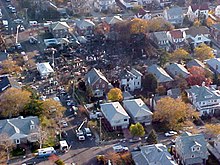

On August 24, 1893, an intense storm, later classified as a hurricane, struck the area and caused Hog Island, a mile-long island off the Rockaway coast where a number of bath houses, restaurants and other leisure-time venues were located, to vanish.[51]
On January 3, 1914, a violent storm devastated the peninsula, and completely swept the Arverne Pier Theater, which was capable of seating 1,200 people, away to sea.[52]
On June 15, 1922, a large part of Arverne was leveled by a disastrous fire which left about 10,000 people homeless, although the neighborhood was quick to rebuild.[53]
On June 6, 1993, a ship called the Golden Venture beached on the shore off Fort Tilden, located on the western half of the Rockaway Peninsula. The ship contained 296 Chinese illegal aliens including 13 crew members. Ten people drowned trying to reach the peninsula's shoreline.[54]
Over 70 Rockaways residents were killed in the September 11 attacks on the World Trade Center in 2001, including people who worked there and New York City Fire Department firefighters and EMS personnel dispatched to the location. The city later opened a small park on Jamaica Bay north of the Beach 116th Street shopping area in Rockaway Park, calling it Tribute Park and dedicating it to the memory of those local residents who were killed on 9/11. On clear days, the park affords an excellent view of the skyscrapers of Lower Manhattan, the former site of the WTC. In the center of the park is a piece of twisted steel from the ruins of the trade center's Twin Towers. Solemn ceremonies are held at the park every Sept. 11, including a reading of the names of all of the locals who perished on that day.
Almost exactly two months after 9/11, on November 12, 2001, American Airlines Flight 587 crashed in Belle Harbor, killing 265 people—260 on board the aircraft and five on the ground. Many of the passengers on the plane were from the Dominican community in Washington Heights.[55] After consultation with the families in the Belle Harbor and Washington Heights communities, a memorial was erected at the south end of Beach 116th Street, a major shopping district and transportation hub in the area, accessible to all. Ceremonies commemorating the disaster are held at the memorial every Nov. 12, including a reading of the names of all of those aboard the aircraft and on the ground killed in the crash. Although a temporary memorial was developed at the actual site of the disaster, on Newport Avenue, many still annually gravitate toward that area for commemoration. In 2001, a resident stated to The Guardian: "It's impossible to understand unless you live here ... Father Michael Geraghty, a priest quoted in the same article, said that it was common for people to live in the houses that their parents lived in and that many families lived in the same houses for generations. The neighborhood suffered heavy losses from the September 11, 2001, terrorist attacks."[56] The impact of the 9/11 attacks and Flight 587 on the community was the subject of the book Braving the Waves: Rockaway Rises, and Rises Again by Kevin Boyle.[note 1] The book contained many personal accounts of Rockaway residents and is liberally interspersed with historical interludes dealing with many times that the Rockaways have been devastated by fire and how its citizens and summer residents have met the adversity.
On April 5, 2011, Georgetown University medical student Jason Maloney landed a single-engine airplane carrying two passengers on the beach at Beach 56th St and Shore Front Parkway. After initially claiming he was required to make a forced landing due to a sick passenger, the pilot admitted he was inspired to perform a beach landing after watching the Discovery Channel show Flying Wild Alaska.[57] The incident remains under investigation by the Federal Aviation Administration.[58]
On September 8, 2012, the peninsula was struck by a tornado shortly before 11 a.m. that started as a waterspout over the Atlantic Ocean and came ashore at the Breezy Point Surf Club.[59]
Rockaway was devastated by Hurricane Sandy in October 2012.[60][61] Many homes in the Rockaways, especially in Breezy Point, were damaged or destroyed by high water, or by fires that raged beyond the capability of first responders to contain them. Residents lost everything in their basements, and hundreds of vehicles were ruined by the storm. One car caught fire when someone tried to start their vehicle, but residents put the fire out before help arrived.[62] On August 4, 2013, Senator Charles Schumer announced that the first phase of reconstruction on the beach, completed, would lay the groundwork for a second contract awarded later during the summer of 2013, totally paid for by the federal government through the Hurricane Sandy relief bill.[63]
During the storm, a fire, which spread between the closely spaced houses of Breezy Point while firefighters' access to the area was greatly hampered by flooding, destroyed 126 homes and damaged 22 more. Thousands of other houses were damaged by flooding. Fires also wreaked havoc along several blocks of Beach 130th Street in Belle Harbor, and among storefronts along Rockaway Beach Blvd. near Beach 114th Street in Rockaway Park. Large portions of the Rockaway boardwalk were swept away by the floodwaters, leaving only its supporting piers visible.[64][65][66][67][68] The FDNY found 130 homes burned to the ground.[69][70] Nearby, another 50 homes were damaged by the fire.[62] According to an official report in December, rising seawater caused the fire by contacting a house's electrical wires.[71] Besides the extensive human, physical and economic damage to the peninsula, the storm also struck a blow against local morale, as "Whalemina," a large, brightly colored statue of a smiling whale that had been a beloved iconic symbol of Rockaway since the 1990s, disappeared from her usual spot at Beach 94th Street near the Boardwalk and was presumed to have been swept out to sea.[72]
Communities
- Arverne – between Beach 56th Street and Beach 79th Street
- Bayswater – located to the northeast of Far Rockaway, along the southeastern shore of Jamaica Bay
- Belle Harbor – between Beach 126th Street and Beach 141st Street
- Breezy Point – located on the westernmost portion of the Rockaways, west of Beach 149th Street
- Broad Channel – while not technically on the peninsula, it is located just north of the Cross Bay Veterans Memorial Bridge
- Edgemere – between Beach 32nd Street and Beach 56th Street
- Far Rockaway – between Nassau County line and Beach 32nd Street
- Hammels – along Beach 84th Street; also extends to Beach 79th Street
- Neponsit – between Beach 142nd Street and Beach 149th Street
- Rockaway Beach – whole south side of island between Beach 102nd Street and Beach 149th Street
- Rockaway Park – between Beach 105th Street and Beach 126th Street
- Roxbury – within Breezy Point, on the north side of Beach Channel Drive
- Seaside – between Beach 84th Street and Beach 105th Street
Education
Like all areas of New York City, Rockaway is served by the New York City Department of Education.
Public elementary and middle schools
- P.S. 42
- P.S. 43
- P.S. 47
- P.S. 104 The Bayswater School
- P.S. 105 The Bay School
- P.S. 106
- P.S. 114
- P.S. 197 The Ocean School
- P.S. 215 Lucretia Mott
- P.S. 225
- P.S. 253
- M.S. 53 Brian Piccolo
- M.S. 183
- M.S. 323
Public high schools
- Far Rockaway High School
- Beach Channel High School
- Stella Maris High School
- Scholars' Academy
- Channel View School for Research
Parochial and private schools
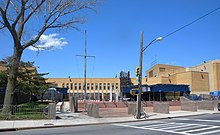
- Beth El Temple
- Chaim Berlin High School
- Hebrew Academy of the Five Towns and Rockaway (HAFTR)
- Mesivta Chaim Shlomo
- Bnois Bais Yaacov
- Tichon Meir Moshe
- Sh'or Yoshuv Institute of Jewish Studies
- Siach Yitzchok Elementary School for Boys
- Torah Academy for Girls
- West End Temple
- Yeshiva Darchei Torah
- Yeshiva of Far Rockaway
- The Hebrew Institute of Long Island
- Yeshiva Bnei Torah
- St. Francis de Sales
- St. Camillus
- St. Rose of Lima
- Church Of God Christian Academy[73]
- St. Mary Star of the Sea
- Scholars' Academy
- Nikitas Language Abroad Schools, a series of language schools
- St. Virgilius School, a Roman Catholic School that was part of the Diocese of Brooklyn, closed in 2006, as part of Bishop Nicholas DiMarzio's effort to close, en masse, Catholic schools with low enrollment.
Synagogues
- Agudath Israel of Long Island
- Agudath Israel of Rockaway
- Agudath Israel of West Lawrence
- Bayswater Jewish Center
- Beis Medrash Ateres Yisroel (Rabbi Avraham Blumenkranz)
- Bnos Israel Institute (Rabbi Shmelke Rubin)
- Congregation Kneseth Israel in Far Rockaway
- Congregation Shaarey Tefila
- Congregation Shaarey Zedek
- Congregation Shomrai Shabbos
- Young Israel of Far Rockaway
- Young Israel of Wavecrest and Bayswater
Libraries

Queens Public Library operates several public libraries in the Rockaways.
A library is planned for the neighborhood, to be built by internationally known architectural firm Snøhetta.[74]
Transportation
Rockaway is served by multiple transportation services.
Trains
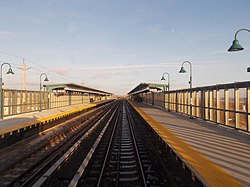
The New York City Subway's IND Rockaway Line (A train), which has a terminal at Mott Avenue, passes through the eastern Rockaways. The A and S trains, which ends at Rockaway Park – Beach 116th Street, serve the central Rockaways.[75] The latter was the terminal of the former Rockaway Beach Branch of the Long Island Rail Road (LIRR).
The Far Rockaway terminal station for the LIRR's Far Rockaway Branch is located in Far Rockaway. The branch had originally been part of a loop that traveled along the existing route, continuing through the Rockaway Peninsula and heading on a trestle across Jamaica Bay through Queens where it reconnected with other branches. Frequent fires and maintenance problems led the LIRR to abandon the Queens portion of the route, which was acquired by the city to become the IND Rockaway Line.[76]
Buses
MTA Regional Bus Operations routes include Q22, Q35, Q52, Q53, Q113, Q114, QM15, QM16, QM17, QM18,[77] and Nassau Inter-County Express (NICE) routes include N31, N32, N33 in Far Rockaway only.[77] Unlike other NICE routes in Queens, these buses operate open-door in Far Rockaway, meaning customers can ride these buses wholly within the neighborhood without necessarily going to Nassau County. NYC Beach Bus, a privately operated shuttle bus between downtown Brooklyn or Williamsburg and the area around Beach 84th Street and Jacob Riis Park, also runs in the area. One can also take a school bus named Rockabus from Williamsburg, Brooklyn.[78]
Ferry
Ferry operator SeaStreak began running a city-subsidized ferry service between a makeshift ferry slip at Beach 108th Street and Beach Channel Drive in Rockaway Park, Queens and Pier 11/Wall Street, then continuing on to the East 34th Street Ferry Landing, after Hurricane Sandy in October 2012 destroyed much of the IND Rockaway Line. In August 2013, a stop was added at Brooklyn Army Terminal.[79]
Originally intended as just a stopgap alternative transportation measure until subway service was restored to the Rockaways, the ferry proved to be popular with both commuters and tourists and was extended several times, as city officials evaluated the ridership numbers to determine whether to establish the service on a permanent basis. The fare was raised to $3.50 per ride during the extension period from $2 previously. Between its inception and December 2013, the service had carried close to 200,000 riders, city officials said.[80]
When the city government announced its budget in late June 2014 for the upcoming fiscal year beginning July 1, the ferry only received a $2 million further appropriation, enough to temporarily extend it again through October, but did not receive the approximately $8 million appropriation needed to keep the service running for the full fiscal year. Local officials and community activists expressed dismay with the decision, saying it was a blow to the Rockaways as the area continues to struggle economically in the aftermath of the 2012 hurricane. A spokesperson for the city government's Economic Development Corporation said that “We will continue to examine ridership and seek a sustainable funding stream that can support the $25-$30 subsidy per trip — the highest by far of any public transportation in the city.” [81] Efforts by local elected officials and community activists to convince the city government to reverse its decision and continue funding the ferry were unsuccessful, and it made its last trip on the night of October 31, 2014.[82]
The Rockaways are expected to be served by the Citywide Ferry Service[83] starting in 2017.[84][85]
Culture
The Rockaway Arts Council provides a wide range of events throughout the year. Two art groups in Rockaway, the Rockaway Theater Company and the Rockaway Artists' Alliance, hold most of their productions in Fort Tilden.
Cultural references include:
- Boardwalk Empire, a popular HBO series is partially filmed at Fort Tilden and the Boardwalk, standing in for Atlantic City in the 1920s.
- Jill Eisenstadt's From Rockaway is set within the world of Rockaway's lifeguard culture during the 1980s.[86]
- In the early 1980s, Christine Lavin, a New York-based folk singer, wrote the poignant song "Rockaway" about her family home.
- Woody Allen's Radio Days, a 1987 movie highlighting the on goings of a working-class family during the golden age of radio, was filmed on location in Rockaway Park, with period facades and cars turning back the clock during the shoot.[87]
- Patricia Reilly Giff's 1998 Newbery Award-winning novel Lily's Crossing is set in the Rockaways. The story, about a girl's friendship with a Hungarian refugee, was partially inspired by the author's own childhood memories of Rockaway Beach during the Second World War. A companion book, Willow Run, features Rockaway as the home of Margaret Dillon, a child whose family in summer 1944 relocates for the rest of World War II to Willow Run, Michigan (now between Ypsilanti, Michigan and Belleville, Michigan) to work at Henry Ford's Willow Run B-24 Liberator bomber plant as part of the United States civilian war effort.
- The 2010 documentary film Our Hawaii, by Kryssa Schemmerling, explores the surf culture that sprung up at Rockaway starting in the late 1960s.[88][89]
Notable people by neighborhood
This section may require cleanup to meet Wikipedia's quality standards. The specific problem is: This notable people section only includes a few neighborhoods and is inconsistent. (November 2015) |
Breezy Point
- Hugh Carey (1919–2011), 51st Governor of New York, was a resident during the time he served in Congress.[90]
- Harry J. Donnelly (1922–1989), politician who served two terms in the New York State Assembly.[91]
- Charles Hynes (1935–2019), district attorney of Kings County, New York from 1990 until 2013.[92]
- Brian McNamee (born c. 1967), former strength and conditioning coach for the New York Yankees and Toronto Blue Jays[93]
- Jimmy Ring (1895–1965), Major League Baseball player[94]
- Daniel T. Scannell (1912–2000), attorney and business executive who held numerous positions in New York's Metropolitan Transportation Authority.[95]
- Bob Turner (born 1941), businessman and politician who served as the United States representative for New York's 9th congressional district from 2011 to 2013.[96][97]
Far Rockaway
- Nisson Alpert (1927–1986), rabbi who was Rosh Yeshiva at the Rabbi Isaac Elchanan Theological Seminary[98]
- Khaleel Anderson (born 1996), politician who has represented the 31st district of the New York State Assembly since 2020[99]
- Richard Bey (born 1951), talk show host; went to Far Rockaway High School[100]
- Baruch Samuel Blumberg (1925–2011), winner of 1976 Nobel Prize in Medicine; graduated from Far Rockaway High School in 1942[101]
- Avrohom Blumenkrantz (1944–2007), Orthodox rabbi who was a widely consulted authority on the laws of Passover kashrut[102]
- Albert J. Brackley (1874–1937), politician who served in the New York State Assembly[103]
- Steven Brill (born 1950), journalist and founder of Court TV[104]
- Joyce Brothers (1927–2013), family psychologist and advice columnist; grew up in Far Rockaway[105]
- Joseph Cassidy (c. 1866–1920), political boss who served as borough president of Queens[106]
- Chinx (1983–2015), rapper, grew up in both the Redfern Houses and Edgemere Houses (the latter are now known as Ocean Bay Apartments)[107]
- Cormega (born Cory McKay, 1970), rapper, lived in Far Rockaway as a youth[108]
- Mac DeMarco (born 1990), Canadian songwriter and musician; has a house in Far Rockaway, where he recorded his album Another One[109]
- Father MC (born 1967), recording artist with Uptown Records[110]
- Folorunso Fatukasi (born 1995), defensive end for the New York Jets[111]
- Olakunle Fatukasi (born 1999), linebacker for Rutgers
- Joan Feynman (1927–2020), astrophysicist and NASA Exceptional Achievement Medal recipient[112]
- Richard Feynman (1918–1988), physicist and Nobel Prize winner; grew up in Far Rockaway and graduated from Far Rockaway High School.[101][113]
- Marcus Gaither (1961–2020), professional basketball player in France and Israel, who played the guard position and led the Israel Basketball Premier League in scoring in 1989–90[114]
- Mary Gordon (born 1949), writer of novels, memoirs, and literary criticism, and professor at Barnard College; born in Far Rockaway and lived there for several years[115]
- Margo Guryan (1937–2021), singer-songwriter, musician and lyricist who is remembered for her 1968 album "Take A Picture"[116]
- Steven Handel (born 1945), educator and restoration ecologist[117]
- Zander Hollander (1923–2014), sportswriter, journalist, editor and archivist[118]
- Carl Icahn (born 1936), businessman and philanthropist; grew up in Far Rockaway and went to Far Rockaway High School[101][119]
- Al Jaffee (1921–2023), cartoonist best known for his work in the satirical magazine Mad, including his trademark feature, the Mad Fold-in[120]
- Nancy Lieberman (born 1958), women's basketball pioneer; grew up in Far Rockaway[121][122]
- Deborah Lipstadt (born 1947), historian[123]
- Bernard Madoff (1938–2021), former American stockbroker, investment advisor, and financier who was convicted of fraud; went to Far Rockaway High School, where he met his wife, Ruth Alpern[124]
- Steve Madden (born 1958), shoe designer and former CEO of Steve Madden Ltd; born in Far Rockaway[125]
- Cliff Mass (born 1952/53), atmospheric sciences professor and weather and climate blogger; born in Far Rockaway[126]
- Alice Nielsen (1872–1943), Broadway performer and operatic soprano; owned a house in Far Rockaway in the 1920s[127]
- Barbara Novak (born 1929), art historian, novelist, National Book Award for Nonfiction finalist[128]
- Phil Ochs (1940–1976), folk-protest singer; resided here for a period during childhood and died at his sister's home here[129]
- Ryan Pearson (born 1990), professional basketball player[130]
- Kelly Price (born 1973), nine-time Grammy nominated R&B and gospel singer and songwriter grew up in the Edgemere Projects[131]
- Rammellzee (1960–2010), rap pioneer; born and died in Far Rockaway[132]
- Kenneth Alan Ribet (born 1948), mathematician
- Burton Richter (1931–2018), winner of 1976 Nobel Prize in Physics; graduated from Far Rockaway High School in 1948[133]
- Gary Schwartz (born 1940), art historian[134][135]
- MC Serch (born 1967 as Michael Berrin), former member of the hip hop group 3rd Bass[136]
- Raymond Smullyan (1919–2017), mathematician; grew up in Far Rockaway[137]
- Herbert Sturhahn (1902–1979), football player elected to the College Football Hall of Fame; born in Far Rockaway[138]
- Conrad Thibault (1903–1987), baritone vocalist who frequently appeared on radio, recordings, and concert tours[139]
$tack Bundles also was a resident of redfern Houses a local celebrity in his own right beloved by the community
Rockaway Beach
- Skip Campbell (1948-2018), Florida legislator and mayor of Coral Springs, Florida born in Rockaway Beach.[140]
- Michael "Iz the Wiz" Martin (1958–2009), one of the most prominent graffiti writers of the early New York graffiti movement.[141]
- Jonathan Monaghan (born 1986), visual artist, born and raised in Rockaway Beach[142]
- Patti Smith (born 1946), punk rocker-poet, wrote about living in Rockaway Beach in her 2015 memoir, M Train.[143]
- Andrew VanWyngarden (born 1983), co-founder of psychedelic rock band MGMT, bought a house in Rockaway Beach in 2012.[144]
- Kenny Vance (born 1943), singer-songwriter and producer.[145]
See also
Notes
- ^ Boyle was also the publisher of the peninsula's newest newspaper, The Rockaway Times. Boyle was the former editor of The Wave, one of Rockaway's local newspapers and the oldest weekly newspaper in New York City.
References
- ^ "Queens Community Boards". Retrieved 18 September 2014.
- ^ Briano, Nicholas (March 21, 2008). "Rockaway Population Popping At Record Pace". The Wave. Retrieved October 18, 2008.
- ^ Governor Kieft's Personal War, Retrieved November 28, 2006.
- ^ Matinecock Masonic Historical Society: History, Retrieved November 28, 2006
- ^ a b "Rockaway..."place of waters bright"". The Wave. Retrieved October 19, 2008.
- ^ a b Jackson, Kenneth T., ed. (1995). The Encyclopedia of New York City. New Haven: Yale University Press. ISBN 0300055366., p. 120.
- ^ The Rockaways. Accessed October 2, 2007. "The Bayswater section was laid out about 1878 by William Trist Bailey, who purchased the property from J.B. and W. W. Cornell. The first Rockaway hunt with hounds started from this spot and the first yacht club was erected there."
- ^ The Big One, New York Press, Retrieved October 18, 2008. "In the years after the Civil War, developers built saloons and bathhouses, and Hog Island became a sort of 1890s version of the Hamptons. During the summers, the city's Democratic bosses used Hog Island as a kind of outdoor annex of Tammany Hall."
- ^ The Big One, New York Press, Retrieved October 18, 2008. "In the dredged-up sand, Coch's students found hundreds of artifacts—plates, whiskey bottles, teapots, beer mugs, lumps of coal and, what proved to be the most telling clue of all, an old hurricane lamp."
- ^ Onishi, Norimitsu (March 18, 1997). "Queens Spit Tried to Be a Resort but Sank in a Hurricane". New York Times. Retrieved 2010-02-25.
- ^ "Before the Five-Borough City: Queens". This map shows the boundaries of the former towns and the former city within the present Borough of Queens.
- ^ Herszenhorn, David M. "THE CENSUS -- A Region of Enclaves: Breezy Point, Queens; Bounded by Gates, Over a Toll Bridge", The New York Times, June 18, 2001. Accessed November 1, 2007. "The neighborhood, started in the early 1900s as a summer bungalow community and called the Irish Riviera..."
- ^ Seyfried, Vincent; Asadorian, William (1999). Old Rockaway, New York, in Early Photographs. Mineola, NY: Dover Publications. p. 93. ISBN 0-486-40668-7. Retrieved 27 January 2012.
- ^ "A Queens Timeline" Archived November 9, 2007, at the Wayback Machine, Queens Tribune; accessed December 14, 2006
- ^ "Club History", Belle Harbor Yacht Club; accessed January 28, 2012 Archived April 16, 2012, at the Wayback Machine
- ^ "The Rockaways". Rootsweb.com. Retrieved December 6, 2006.
- ^ "A Summer Girl Edit". New York Times. May 16, 1904. p. 9.
- ^ "Theme Parks". About.com. Archived from the original on March 19, 2006. Retrieved December 7, 2006.
{{cite news}}: Unknown parameter|deadurl=ignored (|url-status=suggested) (help) - ^ "Rockaway...'place of waters bright'". The Wave. Retrieved December 6, 2006.
- ^ "Neponsit Malls". New York City Department of Parks & Recreation. Retrieved August 7, 2010.
- ^ "Cross Bay Veterans Memorial Bridge, Historical Overview". Retrieved 18 September 2014.
- ^ "Marine Parkway-Gil Hodges Memorial Bridge, Historical Overview". Retrieved 18 September 2014.
- ^ "An Oceanfront Parkway for the Rockaways". NYCroads.com. Retrieved December 6, 2006.
- ^ "Shore Front Parkway and Its Results". The Wave. Archived from the original on 2007-09-28.
{{cite news}}: Unknown parameter|deadurl=ignored (|url-status=suggested) (help) - ^ a b "Hammel Playground". Retrieved 18 September 2014.
- ^ "Rockaway..."place of waters bright""
- ^ Documerica 1973, The Atlantic Magazine
- ^ "Beach Bungalow Historic District" (PDF). National Register of Historic Places Registration Form. National Park Service. 2013. Retrieved November 22, 2013.
- ^ Wilson, Charles (16 March 2012). "The Subway-Accessible, Surf-Ready, Urban Beach Paradise". New York Times Magazine. Retrieved 8 December 2013.
- ^ Steven Hevesi (7 December 2003). "In Rockaways, a Tide Is Coming In". The New York Times. Retrieved 2 February 2015.
- ^ "The New York Racist Float Case: How the First Amendment Does - and Does Not - Protect Racist Cops and Firemen", FindLaw, July 16, 2003.
- ^ Kilgannon, Corey (June 26, 2003). "Ruling in '98 Blackface Case Finds Favor in the Community". New York Times. Retrieved 2010-08-29.
- ^ Cardwell, Diane (April 28, 2006). "Court Upholds City Firings Over Racial Insult at Parade". New York Times. Retrieved 2010-08-29.
- ^ "Arverne by the Sea Website". Retrieved 18 September 2014.
- ^ Arverne East Website
- ^ Rosenberg, Miriam (February 2, 2007). "Rockaway Park Votes 'Go' On Rezoning". The Wave. Retrieved April 7, 2007.
- ^ "4Bloomberg's Big Day In Rockaway" (PDF). The Wave. November 10, 2006. Retrieved May 11, 2012.
- ^ "4Top 10 neighborhoods for real estate investment". New York Daily News. August 10, 2012. Retrieved Oct 15, 2012.
- ^ a b Large-Scale Development: Arverne Archived February 3, 2015, at the Wayback Machine, nyc.gov
- ^ "4Rockaway Beach becomes 'Hipster Hamptons". Newsday. August 13, 2012. Retrieved Oct 15, 2012.
- ^ http://kensinger.blogspot.com/2010/09/south-edgemere-wasteland.html
- ^ Colangelo, Lisa (June 6, 2012). "Renewed hope for barren Far Rockaway Shopping Center". New York Daily News. Retrieved Oct 16, 2012.
- ^ Magoolahan, Brian (March 23, 2007). "Pop! Number of New Residents Surges". The Wave. Retrieved April 7, 2007.
- ^ Rosenberg, Miriam (July 14, 2006). "RB Downzone Debate Rages On". The Wave. Retrieved April 7, 2007.
- ^ "Rockaway Neighborhoods Rezoning". Archived from the original on 20 October 2014. Retrieved 18 September 2014.
{{cite web}}: Unknown parameter|deadurl=ignored (|url-status=suggested) (help) - ^ "Spring Travel: Day Trips," New York magazine, April 23, 2007, p.74
- ^ "Rockaways Hipsterfication Report: MGMT Buys A House, Beer Garden Looms". Gothamist. Retrieved 18 September 2014.
- ^ Michael Idov. "Williamsburg in the Rockaways". New York Magazine. Retrieved Oct 17, 2012.
- ^ "Rockaway Beach is the Hipster Hamptons". am New York. Retrieved 18 September 2014.
- ^ Higgins, Michelle (February 26, 2016) "New York’s Next Hot Neighborhoods" The New York Times
- ^ NORIMITSU ONISHI (March 18, 1997). "Queens Spit Tried to Be a Resort but Sank in a Hurricane". The New York Times. Retrieved November 3, 2014.
- ^ The Wave of Long Island, January 10, 1914, p. 1
- ^ "400 Buildings Burned at Arverne; 10,000 Made Homeless; 60 Injured, Loss $4,000,000 in Half Square Mile". The New York Times. June 16, 1922. Retrieved August 21, 2009.
- ^ Stout, David (November 18, 1995). "Suspected Organizer of Golden Venture Operation Is Arrested". The New York Times. Retrieved March 11, 2008.
- ^ "Plane Crash in Queens." Seconds From Disaster. [documentary TV series]
- ^ Younge, Gary. "Flight to the death: Just two months after 9/11, a Queens suburb suffered the second-worst plane crash in US history. Five years on, residents tell Gary Younge, the cause remains worryingly unresolved", The Guardian, 11 November 2006; accessed 24 January 2008. "On flight 587, myriad immigrant stories of hope foundered. On board was Hilda Yolanda Mayol, 26, a waitress who had escaped from the north tower of the World Trade Center and was heading to the Dominican Republic with her mother and children to take her mind off the trauma."
- ^ Wilson, Michael (April 5, 2011). "Pilot With Sick Passenger Lands on Rockaway Beach". The New York Times.
- ^ Tomassini, Jason (April 6, 2011). "Morning Buzz – Beach Landing Raises Questions". The New York Times.
- ^ "NYC Neighborhood Startled By Unexpected Tornado". Huffington Post. September 8, 2012.
- ^ Shapiro, Lila; Knafo, Saki; Hallman, Ben (October 30, 2012). "Rockaways Face Widespread Destruction: It Was Like Sitting 'In The Middle Of The Sea'". Huffington Post. Retrieved 3 November 2012.
- ^ Conlin, Michelle (October 30, 2012). "Huge fire in Sandy's wake destroys New York City beach community". Chicago Tribune. Retrieved 3 November 2012.
- ^ a b Neumeister, Larry (2012-10-30). "At least 80 flooded houses destroyed by NYC fire". USA Today. Associated Press. Retrieved 2015-11-24.
- ^ "Project adds 600,000 cubic yards of sand to help Rockaway Beach". MyFoxNy. Archived from the original on 9 August 2013. Retrieved 4 August 2013.
{{cite web}}: Unknown parameter|deadurl=ignored (|url-status=suggested) (help) - ^ Nessen, Stephen. "The First Neighbors Return to Devastated Breezy Point". WNYC.org. Retrieved 3 November 2012.
- ^ "Superstorm Sandy's toll: Mounting deaths, historic destruction, stranded residents". CNN. October 30, 2012.
- ^ Sandy (2012-10-30). "Update: Breezy Point, Queens blaze upgraded to 6-alarm fire, at least 50 homes completely destroyed by fire - @FDNY". breakingnews.com. Retrieved 2014-06-11.
- ^ http://www.seattlepi.com/news/us/article/At-least-80-flooded-houses-destroyed-by-NYC-fire-3991949.php#photo-3662958. Retrieved November 5, 2012.
{{cite web}}: Missing or empty|title=(help)[dead link] - ^ Leitsinger, Miranda (2012-11-05). "Parting with life's props: A tough cleanup begins in Breezy Point - U.S. News". Usnews.nbcnews.com. Retrieved 2014-06-11.
- ^ http://news.blogs.cnn.com/2012/10/30/superstorm-sandys-wrath/ hpt=hp_t1
- ^ "Update: Breezy Point, Queens blaze upgraded to 6-alarm fire, at least 50 homes completely destroyed by fire - @FDNY - breakingnews.com". breakingnews.com. Retrieved 18 September 2014.
- ^ "Cause of Breezy Point Fire During Sandy Determined: City Fire Marshals say that rising sea water came in contact with electrical wires". NBC New York. Retrieved 18 September 2014.
- ^ http://www.nydailynews.com/new-york/queens/whalemina-rockaway-beach-mascot-article-1.1211140
- ^ "Church Of God Christian Academy". Retrieved 18 September 2014.
- ^ "Approval Matrix". New York magazine. Sep 30, 2013.
- ^ "Subway Map" (PDF). Metropolitan Transportation Authority. September 2021. Retrieved September 17, 2021.
- ^ IND Rockaway Branch/Jamaica Bay Crossing, accessed June 14, 2006.
- ^ a b Queens Bus Map
- ^ Rock Rock Rockaway Food Stands. Oct. 18, 2012.
- ^ "Seastreak Ferry New Jersey, New York and New Bedford, Martha's Vineyard". Seastreakusa.com. Retrieved 2014-04-20.
- ^ "Rockaway Ferry Floats On Through May, But Trip Will Cost Nearly Double - Rockaway Beach - DNAinfo.com New York". Dnainfo.com. 2014-01-20. Retrieved 2014-04-20.
- ^ http://www.amny.com/transit/rockaway-ferry-service-only-funded-through-october-1.8582809
- ^ http://www.ny1.com/content/news/218228/commuters-bemoan-closing-of-rockaway-ferry/
- ^ DNAinfoNewYork. "Proposed Routes for NYC's Expanded Ferry Service". Scribd. Retrieved September 22, 2016.
- ^ "Citywide Ferry Service to Launch in June 2017, Official Says". DNAinfo New York. 2016-03-03. Retrieved 2016-09-22.
- ^ "New York City's Ferry Service Set to Launch in 2017". NBC New York. Retrieved 9 May 2016.
- ^ Amazon.com: Lily's Crossing
- ^ IMDB: Radio Days
- ^ [1]
- ^ [2]
- ^ "Island profiles: Governor Hugh L. Carey". 8 August 2011.
- ^ "Harry J. Donnelly, 68, Ex-Justice in New York", The New York Times, May 21, 1989. Accessed October 11, 2021. "Harry J. Donnelly a retired acting justice of the New York Supreme Court and a former New York City Highway Commissioner, died of cancer yesterday at St. Vincent's Hospital in Manhattan. He was 66 years old and lived in Breezy Point, Queens."
- ^ Fried, Joseph P. "Charles J. Hynes, Brooklyn D.A. in a Tumultuous Era, Dies at 83", The New York Times, January 30, 2019. Accessed October 11, 2021. "He lived in Brooklyn and Breezy Point in the Rockaways."
- ^ Kovaleski, Serge F. "A Baseball Lover, Key to Tarnishing a Yankee Era", The New York Times, December 15, 2007. Accessed February 19, 2008. "Mr. McNamee was raised in the Breezy Point section of Queens, on the westward end of the Rockaway Peninsula, an area with many police officers, like his father."
- ^ Jimmy Ring, Society for American Baseball Research. Accessed October 11, 2021. "James Joseph Ring died of a heart attack at his summer home on Breezy Point, Queens, on July 6, 1965, at the age of 70."
- ^ Goldman, Ari A. "Man In The News; Acting Transit Chief; Donald Thomas Scannel", The New York Times, August 22, 1983. Accessed October 11, 2021. "The 70-year-old Mr. Scannell had just come back to his summer home in Breezy Point, Queens, after jogging to the beach, where he swam three- quarters of a mile."
- ^ Kaplan, Thomas. "Lawmaker Takes Office and Learns Some Rules", The New York Times, September 15, 2011. Accessed October 11, 2021. "'I felt a certain awe,' Mr. Turner, 70, a retired cable television executive who lives in Breezy Point, Queens, said in an interview."
- ^ "About Bob". Bob Turner for Congress. Archived from the original on October 17, 2011. Retrieved September 10, 2011.
- ^ "Nisson Alpert, 58, a Scholar At Rabbi Elchanan Seminary", The New York Times, May 29, 1986. Accessed March 7, 2024. "Prof. Nisson Alpert, a noted rabbinical scholar at the Rabbi Isaac Elchanan Theological Seminary, an affiliate of Yeshiva University, died of cancer Monday at his daughter's home in Queens. He was 58 years old and lived in Far Rockaway, Queens."
- ^ Khaleel M. Anderson: Biography Archived October 4, 2023, at the Wayback Machine, New York State Assembly. Accessed January 7, 2024. "Assembly Member Anderson is the youngest Black Assembly Member in New York State history. Anderson lives in Far Rockaway, New York."
- ^ Morales, Tina (February 25, 1990). "SCHOOL OF THE WEEK/Far Rockaway High School". Newsday. Archived from the original on July 23, 2013. Retrieved November 25, 2015.
- ^ a b c "The Best Queens Celebrities 2002", Queens Tribune. Accessed November 25, 2015.
- ^ "New York +Boruch Dayan Emmes: Rav Avrohom Blumenkrantz Z”L+" Archived January 8, 2024, at the Wayback Machine, Vos Iz Neias?, February 23, 2007. Accessed January 7, 2024. "The revered Posik and tzaddik, Rabbi Avrohom Blumenkrantz of Far Rockaway, NY, has passed away this afternoon from diabetic complications."
- ^ "Albert J. Brackley; Former Assemblyman Headed Far Rockaway Democratic Club" Archived January 8, 2024, at the Wayback Machine, The New York Times, December 15, 1937. Accessed January 7, 2024. "Former Assemblyman Albert J. Brackley, president of the Far Rockaway Regular Democratic Club, died on Monday night of a heart ailment in his home, 1293 Brunswick Avenue, Far Rockaway."
- ^ Steinbach, Alice. "Steven Brill plans to bring the O.J. Simpson trial to the small screen; Courting TV" Archived June 20, 2021, at the Wayback Machine, The Baltimore Sun, September 25, 1994. Accessed April 8, 2021. "So. How does a kid from the Far Rockaway section of Queens, N.Y., wind up running a mini-empire? In Steven Brill's case it was all because of a broken kneecap."
- ^ "Dr. Joyce Brothers: Television and Radio Writer, Producer, Host". The Paley Center For Media. Archived from the original on November 26, 2015. Retrieved November 25, 2015.
The daughter of lawyers, Joyce Diane Bauer was born in Manhattan and raised in Far Rockaway, Queens.
- ^ "Joseph Cassidy Of Queens Dies; Stricken With Apoplexy at Club, Ex-Leader Expires on Reaching His Home. Twice Borough President One of the Last of the City's Old-Time Political 'Bosses'-Was Long Under Fire.", The New York Times, November 22, 1920. Accessed January 7, 2024. "Joseph Cassidy, former borough President of Queens, and for many years Democratic "boss" of that borough, died suddenly of apoplexy yesterday afternoon at 5 o'clock at his home in Carlton Avenue, in the Hollywood Park district of Far Rockaway."
- ^ "The Break Presents: Chinx Drugz". Xxlmag.com. February 17, 2012. Archived from the original on October 4, 2013. Retrieved October 1, 2013.
- ^ Golianopoulos, Thomas. "The Bridge Is Over; The Queensbridge Houses were once at the center of the rap universe. What happened to hip-hop's most storied housing project?" Archived June 25, 2017, at the Wayback Machine, Complex (magazine), November 25, 2014. Accessed July 16, 2017. "Born Cory McKay in Brooklyn, Cormega moved at an early age from Bedford-Stuyvesant to Co-Op City in the Bronx where he lived on a 22nd floor apartment with a balcony. Life was good until his father discovered crack cocaine. Mega moved to Far Rockaway, Queens, and then he began dealing drugs in Brooklyn."
- ^ "Video // Mac DeMarco Announces New Mini LP + Tour Dates". Captured Tracks. April 22, 2015. Archived from the original on April 23, 2015. Retrieved April 23, 2015.
- ^ Creekmur, Chuck. "Father MC Talks Launching Mary J. Blige & Jodeci, BET, His Career With Diddy & Andre Harrell" Archived February 12, 2023, at the Wayback Machine, AllHipHop, April 13, 2021. Accessed February 12, 2023. "One of those talents was Father MC, the Brooklyn-born, Far Rockaway-bred lyricist."
- ^ Costello, Brian. "Jets land Far Rockaway native in sixth round", New York Post, April 28, 2018. Accessed October 9, 2018. "Gang Green picked defensive lineman Folorunso “Foley” Fatukasi in the sixth round, the 180th-overall pick. Fatukasi grew up in Far Rockaway and played at Beach Channel High School."
- ^ "Scientist Solved Mysteries of the Sun and Magnetic Fields Joan Feynman, sister of a Nobel laureate, made her own mark in physics despite her mother’s doubts" Archived December 14, 2020, at the Wayback Machine, The Wall Street Journal, September 18, 2020. Accessed March 19, 2021. "Joan Feynman was born on March 30, 1927, and grew up in the Far Rockaway section of Queens."
- ^ "Richard Phillips Feynman Facts, information, pictures". Encyclopedia.com. June 10, 2010. Archived from the original on November 26, 2015. Retrieved November 26, 2015.
- ^ Markus, Don. "Gaithers 29 spark FDU win" Archived November 27, 2020, at the Wayback Machine, The Record, December 22, 1983. Accessed November 19, 2020. "Marcus Gaither recently became Fairleigh Dickinson's all-time leading scorer, but the achievement was overshadowed by the confusion the 6-foot-5, 200-pound guard was going through.... A shift to point guard, because of an injury to teammate Freddie Collins, made things even more unsettling for the senior from Far Rockaway, N.Y."
- ^ Genzlinger, Neil. "Margo Guryan, Whose Album Drew Belated Acclaim, Dies at 84", The New York Times, November 24, 2021. Accessed March 7, 2024. "Margo Guryan was born on Sept. 20, 1937, in Hempstead, N.Y., on Long Island, and grew up in the Far Rockaway section of Queens."
- ^ Ginsburg, Elisabeth. "A Well-Traveled Ecologist", The New York Times, November 10, 2002. Accessed March 7, 2024. "As an urban ecologist, Steven N. Handel has traveled from a former landfill near Thoreau's Walden Pond to West Virginia strip mines, but he always returns to the Garden State.... Mr. Handel, who grew up in Far Rockaway, was a 'nature-loving kid,' he says."
- ^ Martin, Douglas. "Zander Hollander, Sports Trivia Shepherd, Dies at 91", The New York Times, April 14, 2014. Accessed March 7, 2024. "Alexander Hollander was born in Brooklyn on March 24, 1923, and grew up in Far Rockaway, Queens."
- ^ Crowe, Portia (May 4, 2015). "Carl Icahn told a story about his dad that always makes him tear up". Business Insider. Archived from the original on November 26, 2015. Retrieved November 26, 2015.
- ^ Gustines, George Gene. "At 99, Al Jaffee Says Goodbye to Mad Magazine As a send-off for the cartoonist, the satirical publication has prepared an all-Jaffee issue that includes his final Fold-In." Archived June 15, 2020, at the Wayback Machine, The New York Times, June 15, 2020. Accessed June 15, 2020. "In 1933, Mr. Jaffee’s father brought Al and two of his brothers back to America for good. The family lived in Far Rockaway, N.Y."
- ^ "Nancy Lieberman player profile". ODU Sports. Old Dominion University. Archived from the original on November 25, 2015. Retrieved November 25, 2015.
On May 6, 2000, the Far Rockaway, NY native earned her degree from Old Dominion University in interdisciplinary studies.
- ^ "Lieberman, Nancy". Encyclopedia.com. May 6, 1996. Archived from the original on November 26, 2015. Retrieved November 25, 2015.
- ^ Moore, Deborah Dash. Deborah Lipstadt Archived September 11, 2023, at the Wayback Machine, Jewish Women's Archive. Accessed February 13, 2019. "Deborah grew up in Far Rockaway, New York. Lipstadt traces her activism back to her parents and Rabbi Emanuel Rackman of the Shaarey Tefila Synagogue in New York."
- ^ Carney, John (December 22, 2008). "The Education of Bernie Madoff: The High School Years". Business Insider. Archived from the original on November 26, 2015. Retrieved November 25, 2015.
- ^ Dominguez, Robert (October 19, 2006). "BRINGING IT BACK HOME. Steve Madden's new ad campaign focuses on his fashion center - Queens". Daily News (New York). Archived from the original on April 17, 2020. Retrieved November 25, 2015.
But Madden was born in Far Rockaway, Queens, where his family is from, and his corporate headquarters are in a huge, Tudor-style building in Long Island City not far from the Queensboro Bridge.
- ^ Henderson, Diedtra (March 19, 1996). "Mass Appeal -- UW Meteorologist Cliff Mass Not Only Knows His Science; He's Also A Whiz At Getting It Across To The Public". The Seattle Times. Retrieved August 2, 2019.
- ^ McNamara, Pat (January 9, 2009). "We Love Our Nielsen". Patheos. Archived from the original on November 25, 2015. Retrieved November 25, 2015.
- ^ Oral history interview with Barbara Novak,, Smithsonian Archives of American Art, October 8-17, 2013. Accessed May 26, 2022. "And then I found out that I could have lessons, art lessons, in one of the big old houses. I remember there was a big white house on [Beach] Ninth Street in Far Rockaway, where I was growing up."
- ^ Tomasson, Robert E. "Phil Ochs a Suicide at 35; Singer of Peace Movement" Archived February 7, 2024, at the Wayback Machine, The New York Times, April 10, 1976. Accessed March 19, 2021. "Mr. Ochs was born in El Paso. His father, a doctor, moved the family to upstate New York when Phil was a few years old. When he was a teen‐ager, the family moved to Far Rockaway."
- ^ Goff, Steven. "George Mason basketball: Ryan Pearson is scarred but not slowed by childhood accident", The Washington Post, February 4, 2011. Accessed February 12, 2023. "'It's a challenge for him every day,' George Mason Coach Jim Larranaga said. 'Whatever obstacles he has had to overcome, he has done it. He has found a way.' The obstacles formed in Far Rockaway, N.Y., a rough area of Queens pinched between John F. Kennedy International Airport, Jamaica Bay and the Atlantic Ocean."
- ^ Musleah, Rahel. "Star in the Making Doesn't Live Like One" Archived October 31, 2020, at the Wayback Machine, The New York Times, September 12, 1999. Accessed March 19, 2021. "Born in Jamaica, Queens, and reared in the Edgemere Projects in Far Rockaway, Ms. Price grew up in a strict Pentecostal home."
- ^ Weiss, Jeff (July 1, 2010). "R.I.P. Rammellzee: The original abstract-rapping outlaw". Los Angeles Times. Archived from the original on July 2, 2010. Retrieved July 3, 2010.
- ^ Crease, Robert P.; and Mann, Charles C. "In Search Of The Z Particle" Archived March 22, 2021, at the Wayback Machine, The New York Times, October 26, 1986. Accessed March 19, 2021. "Burton Richter was born in Brooklyn 55 years ago, but grew up in Far Rockaway, Queens."
- ^ Gary Schwartz Archived June 19, 2018, at the Wayback Machine, Dictionary of Art Historians. Accessed May 5, 2022.
- ^ Brenson, Michael. "An Idiosyncratic Expert Redraws Rembrandt" Archived May 5, 2022, at the Wayback Machine, The New York Times, February 28, 1987. Accessed May 5, 2022. "Gary Schwartz was born in Brooklyn in 1940. His mother was Hungarian; his father, who worked in and eventually took over his father's sweater factory, was of Polish origin. The family moved to Far Rockaway when he was 12."
- ^ Jackson, Brian Keith (October 24, 2007). "Ice, Ice Babies". NYMag.com. Archived from the original on January 6, 2007. Retrieved November 25, 2015.
I grew up in Far Rockaway, and you'd always see shoes on the line.
- ^ "Smullyan biography". University of St Andrews School of Mathematical and Computational Sciences. Archived from the original on October 17, 2018. Retrieved November 25, 2015.
Raymond Smullyan, known as Ray, was brought up in Far Rockaway in New York City.
- ^ "Herbert Sturhahn". National Football Foundation. Archived from the original on February 7, 2024. Retrieved November 25, 2015.
- ^ "Conrad Thibault Dies; An Ex-Radio Vocalist", The New York Times, August 4, 1987. Accessed March 7, 2024. "Conrad Thibault, a popular baritone from the heyday of radio, died Saturday at St. John's Hospital in Far Rockaway, Queens. He was 83 years old and lived in Far Rockaway."
- ^ "Walter 'Skip' Campbell, Broward mayor and former state senator, dies at 69". Tampa Bay Times. October 24, 2018. Archived from the original on January 5, 2020. Retrieved September 18, 2019.
- ^ "Today in Hip-Hop History: The Source Remembers Graf Legend Iz the Wiz on His Birthday - the Source". November 10, 2020.
- ^ "An Interview with Jonathan Monaghan". saic.edu. October 10, 2014. Archived from the original on July 27, 2021. Retrieved July 27, 2021.
- ^ Green, Penelope. "Patti Smith, Survivor; In her new memoir, M Train, the punk elder makes peace with her ghosts and finds solace in a century-old bungalow in the Rockaways." Archived September 13, 2018, at the Wayback Machine, The New York Times, October 3, 2015. Accessed September 13, 2018. "Patti Smith, the musician and author, in the yard of her home in Rockaway Beach, Queens."
- ^ Rockaways Hipsterfication Report: MGMT Buys A House, Beer Garden Looms Archived February 27, 2015, at the Wayback Machine, Gothamist. Retrieved October 16, 2012.
- ^ Rearick, Kristie. "Kenny Vance and the Planotones keep fans happy with stop in Pitman" Archived July 14, 2018, at the Wayback Machine, South Jersey Times, May 17, 2013. Accessed September 13, 2018. "A resident of Rockaway Beach in Queens for 38 years, a visit from Hurricane Sandy last October completely destroyed his home."
External links
- History of Rockaway from The Wave
- Downloadable copy of History of the Rockaways from the year 1685 to 1917 by Alfred H. Bellot
- US Geological Survey for Breezy Point
- The Rockaways by Henry Isham Hazelton (1924)
- Gateway National Recreation Area official website
- Housing Mania in The Rockaways by Angelo Guarino

